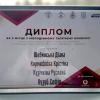Feed aggregator
Please forgive me
 | submitted by /u/Canadian_Rubles [link] [comments] |
✅ Оголошується конкурс на заміщення посад
Національний технічний університет України «Київський політехнічний інститут імені Ігоря Сікорського» оголошує конкурс на заміщення вакантних посад
Multi-solar panel interconnections: Mind the electrons’ directions

The concluding post in a series; here’s part 1 (covering the Energizer PowerSource Pro Battery Generator) and part 2 (discussing its companion 200W portable solar panel)…
Eagle-eyed readers may have already noticed, within the listing for the Energizer Solar Bundle I bought at the beginning of September (and returned shortly thereafter), the following prose:
Pick up another 200-watt solar panel on SideDeal to max out the solar capacity of 400W (but do take note of these instructions)
That I did, for an incremental $179.99. It was (past tense usage because I ended up returning it, too) a “Duracell Heavy Duty 200-Watt Briefcase Solar Panel”, and it also came from Battery Biz. Here are some “stock” images:


Along with a bullet list of specs:
- Brand: Duracell
- Material: Monocrystalline Silicon [editor note: claimed conversion efficiency of 22%]
- Dimensions (unfolded): 55.2 x 36.5 x 1.3 in
- Item Weight: 36.2 lbs
- Maximum Power Point Voltage: 18.6 V
- Maximum Power Point Current: 10.8 V
- Open Circuit Voltage: 22.8 V
- Short Circuit Current: 11.2 A
- Maximum System Voltage (Vmax): 1000VDC
- Normal Operating Cell Temperature (NOCT): 45±2°C
- Temperature Range (°C): -40°C~+85°C
- Power Tolerance: ±5%
- Application Class: Class A
- Included Components: Panel
- Maximum Power: 200 Watts
- Manufacturer: Duracell
When it arrived, the outer packaging was…err…already breached:


Thankfully, the box inside was still intact:

although, as you may have already noticed, the product image on the front didn’t match the “stock” shots, which left me a bit disconcerted before I even opened it.
Here’s the box backside:

Take the “unfolded” dimensions listed in the earlier bullet list, divide the largest by two, and you end up with an approximation of the data shown in this closeup image, which was reassuring:

Open the box, pull out the hefty contents (the promotional prose claims that you can “Experience the convenience of home no matter where you are with our lightweight and foldable solar panel” (foldable = yes, lightweight = not), and the “Zippered Carrying Case with Handle” conceptualized in the previous photo’s graphic is the first thing you’ll come across:

Chug a can of spinach, unzip the case and huff, puff and pull the bulky panel out:

Now undo the clips on the “handle” edge and unfold it:

Like I said, it looks nothing like the “stock” photos, although it ended up being fully functional.
I only realized after returning it that I’d neglected to snap a photo of the backside, so another closeup of the box will have to do:

The cable coming out of the back of the panel terminates in a pair of MC4 connectors:

The also-included adapter cable converts the MC4s into an Anderson PowerPole PP15-45 connector for use with the Energizer PowerSource Pro Battery Generator (along with other Anderson-compatible battery-based products, of course, including Duracell’s own):

Its measured open-circuit output voltage closely approximated the earlier-listed max spec:

and it did charge up the PowerSource Pro reasonably speedily in direct sunlight:

Had I been able to as-intended combine it with the Energizer solar panel, of course, the combo likely would have been speedier still from a charging-rate standpoint. But from my earlier writeup, you already know about the connector woes that prevented such an arrangement and resultant experiment. And since the other gear I’d bought ended up being subpar and sent back to the retailer, I had no other use for this panel, either, so it got returned for full refund, too.


That all said, for the remainder of this writeup I’d like to delve a bit deeper into the suggested dual-panel configuration linked to within the initial Meh teaser and replicated here:

To a first conceptual approximation, you can think of two (or more) solar panels as batteries. Connect them in series and you boost the effective output voltage. Tether them in parallel, conversely, and the aggregate output current goes up. That said, as my research has enlightened me, they also exhibit important differences from batteries in both possible configurations. These variances derive from two fundamental keywords: batteries (ironically) and shade (i.e., “dark”).
Rarely if ever is the solar illumination of a single panel uniform, far from across multiple panels. This inconsistency is due to various factors, such as imperfect orientation versus the sun’s position of the moment in the sky, and the aforementioned shading caused by clouds, trees, and other partially-to-fully obscuring intermediate objects. For series-interconnected panels, illumination inconsistency means that the effective current you’ll be able to squeeze out of a multi-panel configuration is constrained by the least-illuminated panel in the chain. And you’ll of course also want to make sure that the aggregate voltage generated by the multi-panel series arrangement in full illumination doesn’t exceed the max input voltage of whatever it’s driving.
What about multi-panel parallel hookups such as the one recommended in the Energizer documentation? To tether them together requires a combiner cable such as this one I’d bought:

Minimally, you’ll want to ensure that the output voltages of both panels match (for reasons you’ll soon understand) and, this time, that the aggregate current generated by the multi-panel parallel arrangement in full illumination won’t exceed the max input current of whatever it’s driving. “What it’s driving” in my particular case was the Energizer PowerSource Pro Battery Generator, supposedly. Which is where the words “shade” and “battery” fully come to the fore.
Assume first that the combiner cable simply merges the panels’ respective positive and negative feeds, with no added intermediary electronics between them and the electrons’ intended destination. What happens, first, if all the parallel-connected panels are in shade (or to my earlier “dark” wording surrogate, it’s nighttime)? If the generator is already charged up, its battery pack’s voltage potential will be higher than that of the panels themselves, resulting in possible reverse current flow from the generator to the panels. Further, what happens if there’s an illumination discrepancy between the panels? Here again there’ll be a voltage potential differential, this time between them. And so, in this case, even if they’re still charging up the generator’s batteries as intended, there’ll also be charging-rate-inefficient (not to mention potentially damaging; keep reading) current flow from one panel to the other.
The result, described in this crowded diagram from the same combiner-cable listing on Amazon:

is what’s commonly referred to as a “hotspot” on one or all panels. Whether or not it negatively impacts panel operating lifetime is, judging from the online discussions I’ve auditioned, a topic of no shortage of debate, although I suspect that at least some folks who are skeptical are also naïve…which leads to my next point: how do you prevent (or at least minimize) reverse current flow back to one or both panels? With high power-tolerant diodes, I’ll postulate.
Those folks who think you can direct-connect multiple panels in parallel with nothing but wire? What I suspect they don’t realize is that there are probably reverse current-suppressing diodes already in the panels, minimally one per but often also multiple (since each panel, particularly for large-area models, is comprised of multiple sub-panels stitched together within the common frame). The perhaps-already-obvious downside of this approach is that there’s a forward-bias voltage drop across each diode, which runs counter to the aspiration of pushing as much charge power as possible to the destination battery pack. To that point, I suspect this is precisely what this Amazon reviewer is experiencing (also check out the video at the source link):
So I can draw about 86 to 92 watts to my Jackery with the cable from the solar panel but as soon as I plug in the splitter, it drops down to about 60-70 watts. When I plug in both 100 watt solar panels, I get about 120-130 watts. So the splitter somehow loses power when hooked up.
If you look closely at the earlier “crowded diagram” you can see a blurry image of what the combiner cable’s circuitry supposedly looks like inside:

Prior to starting this writeup, I’d returned the original combiner cable I bought, since due to my in-parallel return of the Duracell and Energizer devices, I no longer needed the cable, either. But I’ve just re-bought one, to satisfy my own “what’s inside” research-induced curiosity, which I’ll share with you in a teardown to come. Until then, I welcome your thoughts in the comments!
—Brian Dipert is the Editor-in-Chief of the Edge AI and Vision Alliance, and a Senior Analyst at BDTI and Editor-in-Chief of InsideDSP, the company’s online newsletter.
Related Content
- The Energizer 200W portable solar panel: A solid offering, save for a connector too fragile
- Energizer’s PowerSource Pro Battery Generator: Not bad, but you can do better
- Experimenting with a modern solar cell
- Solar-mains hybrid lamp
- Beaming solar power to Earth: feasible or fantasy?
The post Multi-solar panel interconnections: Mind the electrons’ directions appeared first on EDN.
EPC launches 3-phase BLDC motor drive inverter reference design
Lynred launches Eyesential SW shortwave IR sensor for machine vision
"Корпус та дискурс" на ФЛ
В КПІ ім. Ігоря Сікорського відбулась ІV Міжнародна науково-практична онлайн-конференція "Корпус та дискурс", організована кафедрою англійської мови технічного спрямування №1 факультету лінгвістики. Захід об'єднав понад 100 учасників з різних країн світу – аспірантів, молодих дослідників, викладачів і академіків.
If you can't submit to this sub because you're getting a "You can't contribute to this community yet" message, please know that it's Reddit doing it, not the sub.
If you have an on-topic submission *, please tell the moderators and we can post it for you.
(*) The focal point of a submission must be component-level electronic engineering, design, news, and circuits (with at least one active element: a semiconductor or a vacuum tube/valve).
(*) Questions not allowed.
[link] [comments]
Anatomy of MCUs for motor control

Control MCUs increase performance and efficiency of motor control and power conversion systems by enabling real-time control of systems that need to respond to real-time events with minimal delay and low utilization. These MCUs are targeted at battery-powered applications with motors, large appliances, HVAC units, and power supplies for server farms and cloud computing centers.
Read full story at EDN’s sister publication, Planet Analog.
Related Content
- Advances in MCUs ease motor control
- Optimizing MCUs for EV Motor Control
- Microcontrollers for Motor Control Systems
- MCUs specializing in motor control, power conversion
- Designer’s Guide to High-Performance Motor Control for Robotics
The post Anatomy of MCUs for motor control appeared first on EDN.
Thorlabs acquires strategic partner Praevium Research
Турнір з футзалу пам’яті Віталія Івановича Молчанова 2025
Уже вшосте в спорткомплексі КПІ ім. Ігоря Сікорського відбувся щорічний традиційний турнір з футзалу пам’яті Віталія Івановича Молчанова — справжнього професіонала, видатного освітянина, професора факультету електроніки й до того ж — багаторічного голови Профкому працівників Київської політехніки. Саме профком нашого університету і проводить цей турнір.
Vacuum Tubes (1943) [found footage; covers basic tube and RF rx/tx theory; I found it quite enjoyable so thought to share]
![Vacuum Tubes (1943) [found footage; covers basic tube and RF rx/tx theory; I found it quite enjoyable so thought to share] Vacuum Tubes (1943) [found footage; covers basic tube and RF rx/tx theory; I found it quite enjoyable so thought to share]](https://external-preview.redd.it/_YCih_2ayM0fcaqL6gFvEX_VZVxY-TQnyRAkVto2xm8.jpg?width=320&crop=smart&auto=webp&s=2a450cdbdcd0411c69a2ab1e1a30ef60d67d77ae) | submitted by /u/russellmzauner [link] [comments] |
US CHIPS Incentives Program awards finalized for Corning, Edwards Vacuum and Infinera
A beginner’s guide to power of IQ data and beauty of negative frequencies – Part 2
 Introduction and editor’s note
Introduction and editor’s note
This is a two-part series where DI authors Damian and Phoenix Bonicatto explore the IQ signal representation and negative frequencies. Part 1 explains the commonly used SDR IQ signal representation and negative frequencies without the complexity of math.
This final part (Part 2) presents a device that allows you to play with and display live SDR signal spectrums with negative frequencies.
Wow the engineering world with your unique design: Design Ideas Submission Guide
Defining real and imaginary signalsLet’s start off with something I left out on purpose in Part 1, there are two more terms we will use: A “real” signal is a term used for the signal represented by the I data. “Imaginary” signal is the term used for the signal represented by the Q data. I left them out until now as they add to the obfuscation of the discussion. Just take them at face value as there is nothing imaginary about an “imaginary” signal.
The “I/Q Explorer” designOkay, so what we are going to make is an Arduino Nano based device that can generate “real” and “imaginary” data (I and Q samples) per your settings of frequency, amplitude, and phase. Then it will display a spectrum showing positive and negative frequencies. We will not use the FFT feature of your scope, we will generate the spectrum in the MCU and send it out to the oscilloscope to form a trace in the shape of the spectrum. In fact, we will generate a spectrum for the real signal, imaginary signal, and the magnitude of the combination (this is the square root of the sum of the squares of the real and imaginary signals).
We will refer to this design as the I/Q Explorer (Figure 1).
 Figure 1 The final I/Q Explorer design with an LCD for displaying menu items and values and a toggle switch to switch the scope between the time and frequency domains.
Figure 1 The final I/Q Explorer design with an LCD for displaying menu items and values and a toggle switch to switch the scope between the time and frequency domains.
Let’s look at the schematic in Figure 2.

Figure 2 The schematic of the IQ Explorer device with an Arduino Nano, 4×20 LCD, two rotary encoders, a simple toggle switch, three analog outputs, three lines to go to the scope probes, a digital output, and BNC connectors.
You can see the I/Q Explorer has a relatively simple schematic. It’s based on an Arduino Nano and uses a 4×20 LCD for displaying menu items and values. The two rotary encoders are used to navigate through the menu and to change values. A simple toggle switch is used to change the scope view from the time domain to frequency domain. There are three analog outputs, created using PWM outputs and single pole RC low-pass filters. The three lines go to the scope probes (you don’t need to connect all three if you don’t have a 4-channel scope). There is also a digital output used as a trigger to sync the scope to the analog outputs. The only other electrical parts are two BNC connectors which can be used if you want to get signals from a signal generator, instead of the internal generated signals.
The test stand itself can be easily 3D printed (a link to the 3D files and Arduino code are at the end of the article). The test stand provides a place to mount the LCD, rotary encoders and the time/frequency switch. Two BNC connectors can be installed on the left side. On the right side is a place to install four wires that will be used to clip the scope probe on (you also need to clip one of the leads to a ground). The rest on the circuitry can be laid out on a small solderless breadboard. The breadboard then fits on the back of the test stand. A document showing more images, BOM, and additional instructions can be found in the download from the link at the end of the article.
Using the I/Q ExplorerOk, what can you do with it now? First, the left side of the test stand has four bare wires that are used to connect the scope probes (also connect one scope probe ground to digital ground on the breadboard. The top wire is the real data, the next one down is the imaginary data, then the magnitude, and the bottom one is the trigger. Connect the real, imaginary, and magnitude to the three inputs of your scope (if you only have a two-channel scope, you can connect the real and imaginary only, without missing much). The trigger can be connected to the last scope channel or to the external trigger of your scope.
Now, set the Freq/Time switch to Freq. On your scope, set the vertical to 2v/div, for each of the inputs. Also set the sweep to 20ms/div.
Now you can power the system via the USB connection on the Arduino Nano. Spread out the traces on the scope and set the scope to trigger using the trigger input. You can now hide the trigger trace. The traces should look like what we see in Figure 3.

Figure 3 The starting spectrum from -2500 to +2500 Hz where there is signal energy at both -1500 and +1500 Hz.
Now adjust the horizontal position so the traces are centered. Ignore the time axis on the bottom and the voltage axis on the right side—they are irrelevant (turn them off if your scope has such a feature). The left-to-right axis is frequency with -2500 Hz on the left side and +2500 Hz on the right side. DC or 0 Hz is the center line. (On scopes with 10 major horizontal markings, each major marking measures off 500 Hz increments.) Vertical is only a relative, auto-scaled, value so it is best to keep the volts/div the same for the real, imaginary, and magnitude traces. So, in Figure 3 you can see we have signal energy at both +1500 Hz and -1500 Hz. (Note, on boot up the real signal is 100 while the imaginary amplitude is 0.)
You will see a menu on the I/Q Explorer LCD. Rotating the left rotary encoder will allow you to move up and down in the menu. The right rotary encoder allows you to change the values of the menu item next to the flashing cursor (second line from the top of the LCD). In the menu you can change the frequency, amplitude and the phase of the real (I data) or imaginary (Q data) signals.) Note that changing the frequency of either the real or imaginary will change the other—they need to be at the same frequency.) The menu also has items to print data, plot data, turn on/off windowing, turn on/off a mixer, and change the source for the FFT from the internal generated data to external signal from a signal generator.
As a sanity check, Figure 4 is a plot of the real output from a simulation package using the same signals, sample rate, and number of samples. These are as follows: The real signal used has an amplitude of 100 and the imaginary signal has an amplitude of 0. The frequency of both is 1500 Hz. The sample rate is 5000 samples/second and the number of samples used in the FFT is 64.

Figure 4 Real FFT simulation using the same settings where the real signal has an amplitude of 100, the imaginary signal has an amplitude of 0, the frequency of both is 1500 Hz, the sample rate is 5000 samples/second, and the number of samples used in the FFT is 64.
You can see that the real signal matches nicely.
Adjusting real and imaginary signal settingsLet’s change the imaginary signal so it has the same amplitude as the real signal. Set the imaginary amplitude to 100. Now we get the following in Figure 5.

Figure 5 The FFT when imaginary and real amplitudes are the same (set to 100).
You can see we only have a signal at +1500 Hz…there is no negative frequency component.
If we flip the Freq/Time to “Time” you will be able to see the time domain samples used to generate the FFT, without adjusting anything on the scope.
Mixer modeNow let’s try quadrature (complex-to-complex) mixing. Move down in the menu and turn on “Mixer” (more on moving and adjusting settings in the download). This will do the mix using the real and imaginary signals you have sets, and a fixed signal having its real and imaginary setting of 1000 Hz, and amplitudes of 100 and phases set to 0. What you will at first is shown in Figure 6.

Figure 6 Quadrature mixing of 1500 Hz with 1000 Hz showing the signal at 500 Hz and an image created at 2000 Hz.
You can see two things. First, the signal is now at 500 Hz, the difference of 1500 Hz from our signal and the 1000Hz from the mix signal. Second, there is an image created at 2000 Hz (1500 Hz + 500 Hz) but it has been removed by the mathematics of the mixer.
Next change the frequency of the real or imaginary signal (remember one will change the other) to 500 Hz. Also note, as you turn the dial, the FFT frequency will slide down as you approach 500 Hz. And as you go past 1000 Hz you will see the FFT in the negative frequency area. When you get to 500 Hz you will see this in Figure 7.

Figure 7 Quadrature (complex-to-complex) mixing of 500 Hz with 1000 Hz.
You now have generated a negative frequency—as simple as that.
Note that you can also see the plot, of any of the displayed FFTs, on the PC by using the “Serial Plot” selection. You can also get a view of the numerical data by using the “Serial Print Data” selection.
More fun IQ manipulationSo now that you’ve seen a few examples, you can explore I/Q data and quadrature mixing by changing things like the amplitude of the real and/or imaginary signals. Also, try changing the phase of signals. After you get a grasp of that try changing the phase of either. To get a real handle on this, see if you can manipulate the trig equations to better understand how you get to that FFT. The system also has a windowing function, you can play with, that adjusts amplitudes of the data points before the FFT is calculated (for those who know these things, it is a Hann window).
Remember, you can also use actual external signals, such as those from a two-channel signal generator, to perform the same tests. You’ll note though, the FFTs are not quite as stable. There is more information on that in the downloadable notes.
One last thought; you’ll find lots of discussion on whether negative frequencies are real (in the traditional sense) or not. My two cents is they are not physically real as they cannot be transmitted as a single waveform, but they are a very nice mathematical construct that allows us to manipulate the signals that we can receive. Let the arguing begin.
To download 3D printable files and document containing more operating info, a BOM, and extra photo, visit: https://makerworld.com/en/models/1013533#profileId-993290
The Arduino Nano code can be found at: Arduino Nano code can be found at: https://github.com/DamianB2/IQ_Explorer
Damian Bonicatto is a consulting engineer with decades of experience in embedded hardware, firmware, and system design. He holds over 30 patents.
Phoenix Bonicatto is a freelance writer.
Related Content
- A beginner’s guide to power of IQ data and beauty of negative frequencies – Part 1
- Exploring software-defined radio (without the annoying RF) – Part 1
- Exploring software-defined radio (without the annoying RF)—Part 2
- SDR Basics Part 3: Transmitters
- The virtual reality of 5G – Part 2 (measurements)
- Ultra-wideband I/Q demodulator improves receiver performance
The post A beginner’s guide to power of IQ data and beauty of negative frequencies – Part 2 appeared first on EDN.
Антикорупційний комікс від студенток КПІ: від ідеї до перемоги у всеукраїнському конкурсі
У молодіжному творчому конкурсі "Разом проти корупції! Твоє бачення має значення", що проводився Міністерством оборони України з нагоди Міжнародного дня боротьби з корупцією, друге місце вибороли студентки другого курсу факультету соціології і права КПІ ім.
Innoscience files lawsuits against Infineon in China
🏰 Запрошуємо на виставку «Із полумʼя зродились»
Запрошуємо на виставку «Із полумʼя зродились» у КПІ ім. Ігоря Сікорського, яку присвячено українським військовим, волонтерам та медикам!
Мистецтво лікує. Майстер-класи "Малюй з воїном"
Люди, які зіткнулися з травматичними подіями – стали свідками або учасниками війни, терористичних актів, природних катастроф чи насильства, – можуть мати проблеми із психікою. За даними Всесвітньої організації охорони здоров'я, кожна п'ята особа, яка мала травматичний досвід, потребує психологічної реабілітації. Одним із дієвих методів роботи з психотравмами є арттерапія.
📣 Команда «Прозорих міст» росте, розвивається та пропонує одразу аж три круті вакансії!
Наразі шукають:
Nvidia, TSMC, and advanced packaging realignment in 2025

Nvidia’s CEO Jensen Huang has made waves by saying that his company’s most advanced artificial intelligence (AI) chip, Blackwell, will transition from CowoS-S to CoWoS-L advanced packaging technology. That also shows how TSMC’s advanced packaging technology—chip on wafer on substrate (CoWoS)—is evolving to overcome interconnect battles inside large, powerful chips for AI and other high-performance computing (HPC) applications.
The CoWoS-S advanced packaging technology uses a single silicon interposer and through-silicon vias (TSVs) to facilitate the direct transmission of high-speed electrical signals between the die and the substrate. However, single silicon interposers often confront yield issues.
On the other hand, CoWoS-L, TSMC’s latest packaging technology, uses a local silicon interconnect (LSI) along with an RDL interposer to form a reconstituted interposer (RI) to enhance chip design and packaging flexibility. It also preserves the attractive feature of CoWoS-S in the form of TSVs while mitigating the yield issues arising from the use of large silicon interposers in CoWoS-S.
According to Reuters, Nvidia is selling its Blackwell chips as quickly as TSMC can manufacture them, but packaging has become a bottleneck due to capacity constraints. That’s startling because, as Huang noted, the amount of advanced packaging capacity at TSMC is probably four times the amount available less than two years ago.

Figure 1 CoWoS-L marks a significant advancement over CoWoS-S in terms of performance and efficiency for AI and HPC applications. Source: TSMC
Huang also told Taiwanese reporters that Nvidia is still producing Blackwell’s predecessor, Hopper, using TSMC’s CoWoS-S advanced packaging technology. “It’s not about reducing capacity. It’s actually increasing capacity into CoWoS-L.”
Advanced packaging in flux
Nvidia’s foray into new technology is a stark reminder of how quickly advanced packaging needs are changing. Apparently, the semiconductor industry is eying a new set of advanced packaging building blocks to dramatically increase the bandwidth and interconnect density of AI chips.
TSMC’s CoWoS is a 2.5D semiconductor packaging technology that increases the number of I/O points while reducing interconnect length between logic and memory components. However, emerging HPC workloads, particularly those related to AI training, demand even higher memory bandwidth due to frequent memory accesses.
CoWoS-L can stack up to 12 HBM3 devices at a lower cost than CoWoS-S and thus has the potential to become the mainstream CoWoS technology for future AI chips. Beyond CoWoS-L, TSMC is warming up to co-packaged optics (CPO), which replaces traditional electrical signal transmission with optical communications.

Figure 2 TSMC has made significant progress in its silicon photonics strategy by integrating CPO with advanced semiconductor packaging. Source: TrendForce
The current AI chips use copper interconnects, which increasingly face bottlenecks as bandwidths widen. In CPO, optical interconnect signals can achieve higher bandwidth than their electrical counterparts. For instance, CPO supports up to 1.6 Tbps bandwidth, which is 1.8 times wider than Gen 4 NVLink interconnect used by Nvidia in its current GPUs. Moreover, power consumption is also up to 50% lower.
According to Taiwanese media outlet UDN, TSMC has completed the development of CPO, and it plans to provide CPO samples to two of its major customers, Broadcom and Nvidia, later this year. Furthermore, UDN reports that TSMC plans to scale up the production of CPO in 2026.
AI chips constituting high logic-to-logic and logic-to-memory bandwidth are driving innovations in the advanced packaging realm. The move from CoWoS-S to CoWoS-L and the advent of CPO are harbinger of this pivot in the semiconductor industry ecosystem, which is now increasingly driven by AI applications.
Related Content
- Advanced Packaging and Chiplets Can Be for Everyone
- TSMC crunch heralds good days for advanced packaging
- After TSMC fab in Japan, advanced packaging facility is next
- Understanding the Big Spend on Advanced Packaging Facilities
- Advanced IC Packaging: Fundamentals for the ‘More than Moore’ Era
The post Nvidia, TSMC, and advanced packaging realignment in 2025 appeared first on EDN.
LED lantern with the diffuser removed
 | submitted by /u/4b686f61 [link] [comments] |









